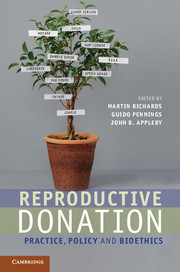Book contents
- Frontmatter
- Contents
- Contributors
- Acknowledgements
- 1 Introduction
- 2 The biology of donation
- 3 Ethics for reproductive donation
- 4 Parenthood – whose right is it anyway?
- 5 Reproductive donation
- 6 UK and US perspectives on the regulation of gamete donation
- 7 Gamete and embryo donation
- 8 The legal and ethical regulation of transnational donation
- 9 Balancing ethical criteria for the recruitment of gamete donors
- 10 Challenges in intra-family donation
- 11 ARTs and the single parent
- 12 Reproductive donation and justice for gay and lesbian couples
- 13 Is disclosure in the best interests of children conceived by donation?
- 14 Identifiable donors and siblings
- 15 Ethical issues in embryo donation
- 16 Reproduction through surrogacy
- 17 Some conclusions regarding the interaction of normative and descriptive elements in reproductive donation
- Index
- References
11 - ARTs and the single parent
Published online by Cambridge University Press: 05 August 2012
- Frontmatter
- Contents
- Contributors
- Acknowledgements
- 1 Introduction
- 2 The biology of donation
- 3 Ethics for reproductive donation
- 4 Parenthood – whose right is it anyway?
- 5 Reproductive donation
- 6 UK and US perspectives on the regulation of gamete donation
- 7 Gamete and embryo donation
- 8 The legal and ethical regulation of transnational donation
- 9 Balancing ethical criteria for the recruitment of gamete donors
- 10 Challenges in intra-family donation
- 11 ARTs and the single parent
- 12 Reproductive donation and justice for gay and lesbian couples
- 13 Is disclosure in the best interests of children conceived by donation?
- 14 Identifiable donors and siblings
- 15 Ethical issues in embryo donation
- 16 Reproduction through surrogacy
- 17 Some conclusions regarding the interaction of normative and descriptive elements in reproductive donation
- Index
- References
Summary
What are single parents by choice?
Single parents by choice (SPCs) are single men (single fathers by choice), or women (single mothers by choice), who actively choose to parent a child without a partner. The term single mother by choice (SMC) has been used to describe a distinct group of women who differ in a number of ways from mothers who either conceive accidently or become single after separation or divorce (Chan et al., 1998; Mannis, 1999; Murray and Golombok, 2005a, 2005b). They are often older women, predominantly heterosexual, in their thirties and forties, well educated and financially independent (Murray and Golombok, 2005a, 2005b; Hertz, 2006; Jadva et al., 2009a). There is currently a dearth of academic literature concerning single fathers by choice (SFCs) and little is known about such men or the children they raise.
Routes to single parenthood by choice
An SPC decides to have a child knowing that they will parent that child, at least initially, without a partner. This can be achieved via various routes and does not necessarily have to incorporate the use of Assisted Reproductive Technologies (ARTs). A woman could embark upon single motherhood by choice through sexual intercourse, donor insemination (DI) at a clinic, self-insemination with a known or anonymous donor, as well as through adoption or fostering (Bock, 2000; Hertz, 2006). Research has shown that different women choose different methods depending upon their circumstances, the options available to them and their beliefs about the morality of different methods. For example, some women may feel it is wrong to deceive a man by purposefully getting pregnant through a sexual encounter (Bock, 2000; Murray and Golombok, 2005a) while others feel that adoption is a morally superior route to single motherhood (Mannis, 1999; Morrissette, 2008). However, for many women adoption is seen as a last resort (Hertz, 2006), wanting instead to experience pregnancy and have genetically related children. Indeed, Jadva et al. (2009a), in their survey of 291 women using the US-based website ‘choice moms’, found that the most common method used to become an SMC was DI at a clinic: single motherhood by choice was most commonly pursued through the use of ARTs.
- Type
- Chapter
- Information
- Reproductive DonationPractice, Policy and Bioethics, pp. 189 - 210Publisher: Cambridge University PressPrint publication year: 2012
References
- 9
- Cited by



